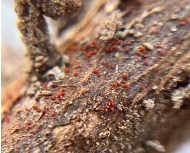Westfield, Indiana, USA
October 10, 2023

Tiny, bright red pustules on soybean roots are a telltale sign of red crown rot, a disease that severely affects yields and is spreading throughout the Midwest.
Red crown rot is a fungal disease of soybeans that has been common in the southern U.S. for years. AgriGold agronomist Brett Leahr is concerned about the spread of the disease in his Illinois territory and has seen the disease firsthand scouting fields.
Red crown rot is caused by the soilborne fungus Calonectria ilicicola and can have a severe impact on soybean yields. “It shuts the plant down as fast as possible,” says Leahr. “It can take an 80-bushels-per-acre field to 20 bushels per acre.”
While there’s still a lot to learn about managing red crown rot, Leahr wants farmers to know what to look for. “From afar, red crown rot looks similar to sudden death syndrome (SDS),” he says. “But red crown rot moves very fast and appears to kill the plant much more rapidly than SDS. You see a little spot of it pop up and you come back a couple days later in the field and it’s just exploded.”

AgriGold agronomist Brett Leahr tells farmers to scout for red crown rot and keep detailed records to help manage it in the future.
Leahr recently conducted a soybean plot study that demonstrated the effect of moisture on red crown rot. During the recent dry period, he marked the rows he watered. “When I went back a few weeks ago, red crown rot was in the exact areas we watered, so it clearly loves moisture,” says Leahr.
“I think this year it fell with rain patterns – where we had those early rains is where we’re seeing it pop up,” he adds.
To understand the impact of red crown rot and prepare to manage it in the future, Leahr says farmers should do two things: scout and document.
What to look for when scouting
Because red crown rot looks similar to SDS or brown stem rot, it’s important to verify its presence by inspecting the root system. “If you see slightly off-pitted soybeans, the first thing to look for is interveinal chlorosis or yellowing,” says Leahr. “The next step is to pull the plant up, knock the soil off the roots as gently as possible and look for red streaking on the stem around the soil line.”
A distinctive sign of red crown rot is the presence of red pustules on the root system. “If you look at the root system and see tiny, bright red balls – get a magnifying glass if needed – it’s red crown rot,” he says. “SDS will have the exact same leaf orientation and interveinal chlorosis, but with more of a turquoise or teal color on the roots.”
Importance of documentation
A record of which fields have red crown rot helps farmers and agronomists know which fields may be affected in the future. “Some farmers who have red crown rot on their soybean acres right now may not remember if a field had it before,” says Leahr. “That’s why good documentation helps when planning future soybean acres.”
AgriGold is proud to offer Saltro® seed treatment, which is approved in Arkansas, Indiana, Kentucky, Tennessee, Illinois, Iowa, and Missouri, to suppress red crown rot. Always follow label instructions.
Farmers that detect red crown rot in fields – or think it may be present – should work with a crop advisor, extension specialist or their AgriGold agronomist to confirm the diagnosis and create a management plan for the future.

Caption: Tiny, bright red pustules on soybean roots are a telltale sign of red crown rot, a disease that severely affects yields and is spreading throughout the Midwest.

Caption: AgriGold agronomist Brett Leahr tells farmers to scout for red crown rot and keep detailed records to help manage it in the future.